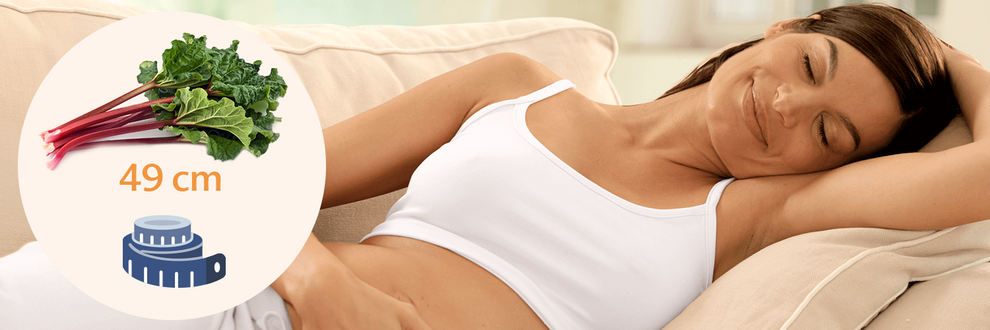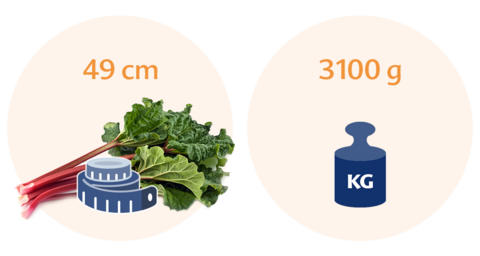Pregnancy weeks:
Week 38 of pregnancy: Time to make the last preparations for your baby

As week 38 begins, you’re in the second week of the tenth month of your pregnancy. A lot has already changed in your life, but there’s no feeling quite like the joyful anticipation when you’re about to meet your baby.
Size of your baby in week 38

Your baby has grown another centimetre in length and now measures 49 cm long – about as big as a stick of rhubarb. They now weigh 3096 grams, so more than 3 kilograms, and they’re quickly approaching their birth length and weight.
Your baby’s development
Your baby’s head has grown a bit more and now has a diameter of about 32 cm. The time they have left before the birth will be spent preparing their lungs for the dramatic moment when they breathe for the first time: your body is now producing cortisone, which helps their lungs to fully expand when they take their first breath and not stick together. From that moment on, your baby can breathe independently and can survive outside the womb.
In week 38, your baby won’t be moving very much. This is partly because they haven’t got much space, but also because they need to rest and prepare for the birth. False labour has moved them down deep into your pelvis and they should have adopted the birth position, though a few babies don’t quite manage this and may need external help.
During your appointments at this stage, your doctor can use an ultrasound, if necessary, to determine whether the placenta is still doing everything it should be doing – i.e., if it is still supplying your baby with what they need. If not, your doctor may decide to induce birth after considering the situation and weighing up the risks and benefits for your baby and their continuing healthy development.
Your doctor can also estimate a likely date for the birth. If this is soon, and if a CTG makes clear that you’re already experiencing short, irregular contractions, it may be better to induce birth. This depends on your baby’s situation and vital signs, which indicate whether they’re under a lot of stress. There are natural, gentle ways to induce birth which your uterus will react to positively, and which will encourage your baby to move their head further down into your pelvic ring when the time comes.
What it’s like for the mum-to-be in week 38
The suspense will be almost unbearable, and you’ll be restless and irritable. The pressure your baby is putting on your pelvic floor will still give you back and abdominal pain, which will put your nerves on edge. It’ll almost certainly be similar for your partner: most dads-to-be feel helpless at this stage, particularly if this is your first child, as they don’t know when it’s finally going to happen either.
It is important to keep yourself relaxed. For some, exercises such as walking or swimming are great ways to relax. You can also listen to soothing music, which can calm your baby down too. Read a book or magazine leisurely and enjoy the last days of your pregnancy.
Common signs and symptoms
Your body prepares for the birth
If your body is ready for the birth, your mucus plug now loosens. Throughout your pregnancy it has “sealed” your cervix and ensured that no bacteria could get through to your uterus. When it loosens, you will notice increased white discharge (which can also contain a small amount of blood) – this is often called the “bloody show”. Once this happens, the process of giving birth will usually begin 24 hours later with real labour, which will last a few days and includes irregular contractions before the birth itself.
Other signs can be heartburn, nausea, diarrhoea and tiredness – your body is preparing you for birth and beginning to “cleanse” itself. Feeling tired is your body’s way of telling you to rest and gather your thoughts.
So in week 38, you should listen to your body, pay attention to the symptoms you experience and try to relax otherwise. Enjoy the last few days of your pregnancy – before too long, you and your partner will be welcoming the newest member of your family.
Questions you may want to ask your doctor
What if my baby doesn’t want to turn?
Some babies struggle to move into the birth position in week 36. There can be various reasons for this, ranging from disease or disability in the baby to mental overload in the mum-to-be, which prevent the baby from getting ready for birth. If your baby has a disease or a disability, a caesarean section is usually the best way to give birth. However, sometimes there’s no apparent reason why your baby won’t get into the birth position. If so, modern obstetric medicine has plenty of methods and techniques to get your baby to turn around (which should be used back in week 34), and your doctor will have the knowledge and skill to help in this case.



